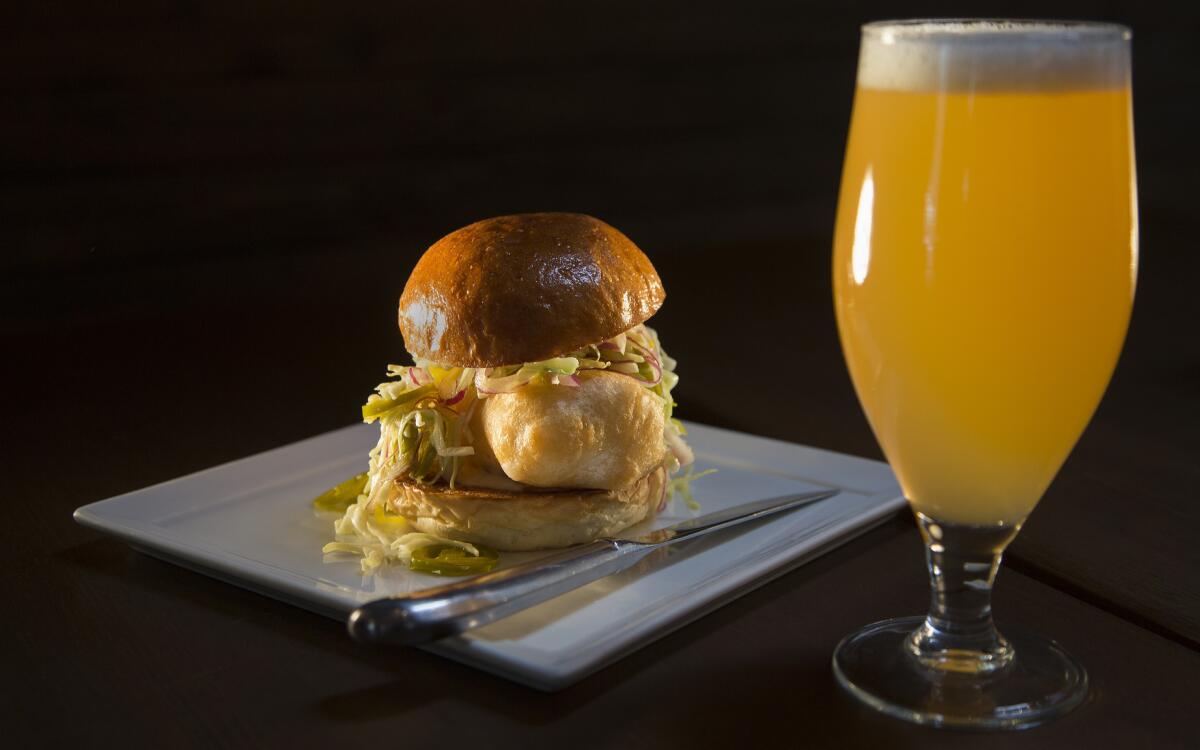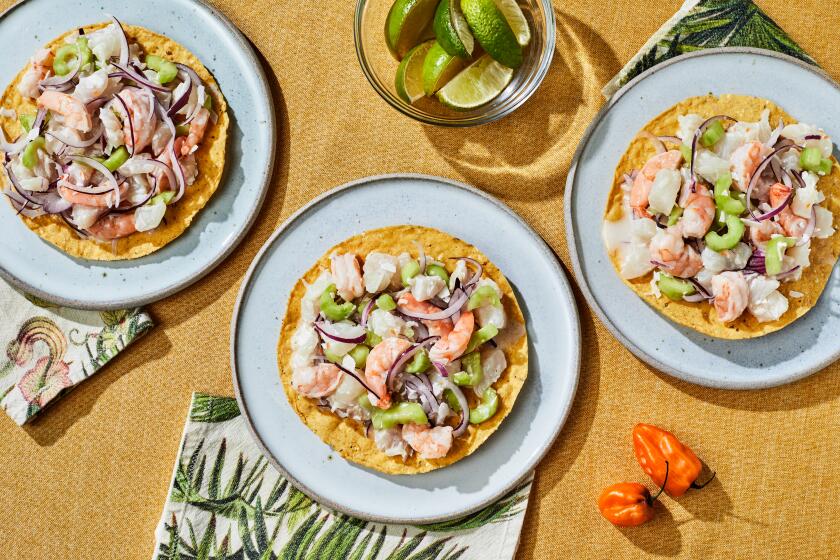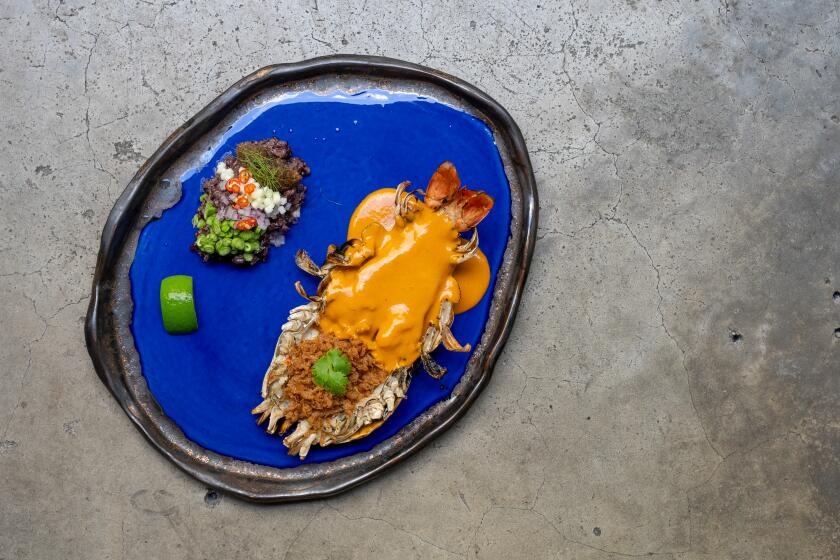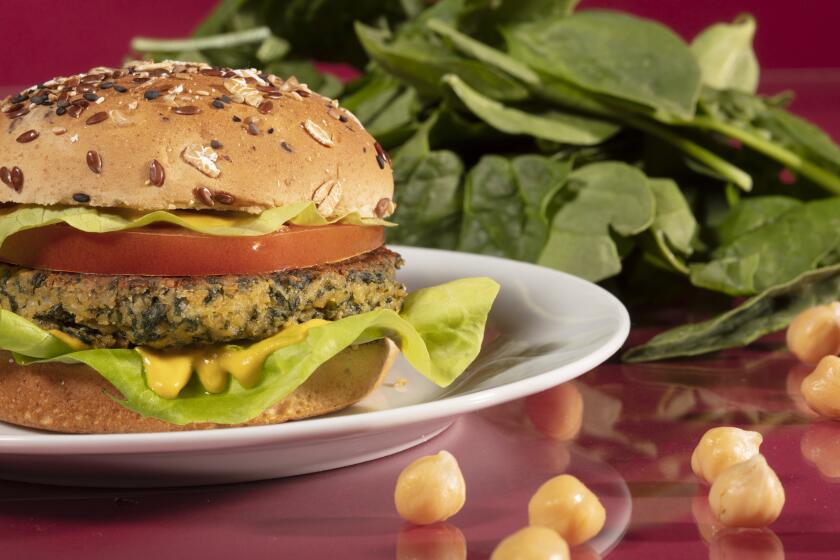Eagle Rock Public House's fried cod sandwich

It’s one thing to pair beer with food, especially for holidays or events like this weekend’s 50th Super Bowl — where you’ll probably be serving or drinking a lot of it — but beer is also pretty fun to cook with. (After all, we do it with wine all the time.) You can add beer to almost anything, from chili to shrimp boils, bread and cakes to queso. More than just a novelty ingredient, beer adds an extra dimension and depth to a dish, lending notes ranging from roasted barley to sweet fruit, chocolate to molasses.
“Craft beers have a lot of personality, but there’s a lot you can do with regular commercial brews too,” says Jerry Su, chef at Eagle Rock Brewery Public House, the restaurant outlet for one of Los Angeles’ most popular craft breweries. In fact, for a lot of cooking, commercial brews are ideal, simply because the price point is better than for more limited craft offerings. “Coors is a natural for a shrimp boil. With commercial beers, you can also trust that the flavor is consistent. You know what you’re getting.”
First, consider the type of beer you want to use and what style would best complement a dish. Wheat beers — often called “white,” “wit” or “weiss” — tend to be a little more mellow, with crisp, fruity notes that can pair well with everything from fish to grilled red meats.
Su uses Eagle Rock Brewery’s Manifesto beer in a light batter for the restaurant’s deep-fried cod sandwich, topped with a pickled jalapeño slaw and tangy malt vinegar aioli. The Belgian-style wheat beer is not too terribly hoppy or bitter, perfect with fish. “It’s mild,” says Su, “and lends great flavor.”
Other beers run the gamut from fruity and sharp to yeasty and malty. Take a complex stout beer — rich and dark, this beer is thick and creamy, redolent with molasses, coffee and roasted barley notes. The flavors are naturally suited to grilled meats, hearty stews and rich desserts.
Depending on how the beer is used in a recipe, the flavors can change as you cook with them. Add beer toward the end of a recipe, and the notes will largely remain true to the beer’s original character. But try cooking — particularly heating and reducing beer — and the flavors will concentrate and even evolve over time.
For stout and mustard chicken wings, complement a robust stout reduction with whole grain mustard and chopped garlic, along with minced thyme. A little honey and malt vinegar will offset the bitterness of the reduced beer, and grated Parmesan and soy sauce will add a touch of umami to your glaze.
“The key is using your palate and working with the harmony of flavors,” says Su. “Try a small amount [of beer] before adding it to a recipe.”
Keep in mind that as the beer is cooked, most, if not all, of the alcohol will burn off. And unlike wine, the carbonation in the beer can make it a valuable ingredient for certain types of dishes, particularly when it comes to deep-frying.
“Beer batter is something that’s super common,” says Su. Whisked into a simple batter consisting of nothing more than flour, salt and a touch of baking powder, a beer batter puffs up light and crisp. It’s a classic batter for deep-fried fish.
For a slightly different take, use it to batter mac-and-cheese bites, incorporating a sharp, bitter IPA to stand up to the richness of a cheddar- and smoked-gouda-based sauce.
Experiment a bit and you might find yourself cooking with beer frequently and using it in a variety of dishes. Still, always be sure to keep extra on hand — you know, for when you actually want to drink it.
Basic sweet pickled jalapeño
In a heavy saucepan, combine the vinegar, water, salt and sugar over high heat until it comes to a boil. Remove from heat. Place the jalapeños in a large jar or medium glass bowl and pour over the liquid. Weight the jalapeños down so they stay submerged, and set aside until cool. Cover and refrigerate the submerged jalapeños for at least 12 hours to pickle. The jalapeños will keep for up to 2 weeks, covered and refrigerated.
Pickled jalapeño slaw
In a large bowl, mix together the julienned cabbage and red onion, along with the strained pickled jalapeños.
In a small bowl, whisk together the pickling juice with the vinegar and olive oil to make a vinaigrette. Pour the vinaigrette over the slaw and season with a few pinches of salt to taste. Mix the slaw well and set aside for at least 10 minutes before using. This makes 6 to 8 cups slaw, possibly more than is needed for the rest of the recipe; the slaw will keep, covered and refrigerated, up to 3 days.
Malt vinegar aioli
In the bowl of a food processor, combine the egg, yolk, mustard, lemon juice, garlic and kosher salt, blending until homogenous. With the processor running, slowly stream in the oil. As the oil is added, the mayonnaise will begin to emulsify and stiffen. Enough oil has added when the mayonnaise is thick and will form peaks. Stir in the malt vinegar by hand to form the aioli. This makes a generous cup aioli, which will keep, covered and refrigerated, up to 1 week.
Fried cod sandwich
Fill a 4-quart pot with frying oil to a depth of 3 to 4 inches. Heat the oil to maintain a temperature of 350 degrees.
Meanwhile, in a large bowl, whisk together 1 1/2 cups flour with the baking powder and kosher salt. Whisk in the beer unti the batter is smooth, then whisk in the Tabasco. Set aside.
Dredge the cod pieces in the remaining flour, then remove the cod and dip each piece into the batter. Carefully lower each piece into the oil and fry until golden and crispy, about 4 minutes (frying time will vary depending on the thickness of the pieces). Drain on a rack.
Assemble the sandwiches: Spread 1 to 2 tablespoons aioli on each half of the toasted rolls. Top the bottom half of each roll with a piece of fried fish, and top the fish with about 1 cup of loosely packed slaw. Top each sandwich with the remaining roll and serve immediately.
Get our Cooking newsletter.
Your roundup of inspiring recipes and kitchen tricks.
You may occasionally receive promotional content from the Los Angeles Times.
















